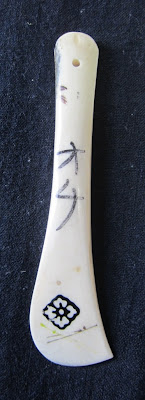Zyta only began sashiko last year and her first piece was one of the viewers' choice winners in our exhibition in October. Zyta's hanten was inspired by traditional sashiko stitched and patched fishermen's hanten. She has beautifully stitched the lining as well but somehow I forgot to get photos so I'll add them later if I get a chance.
Zyta's sashiko reflects what I love about a lot of old sashiko. It's a very individual piece which is full of character and shows the hand of the person who created it. There is a warmth to Zyta's stitching which has been lost in many modern sashiko projects. We think of sashiko being traditionally done on plain indigo but it was often stitched on patterned indigos such as kasuri (ikat) as well. The floral katazome panels wouldn't have been typical on fishermen's hanten but give it a more feminine feel and look stunning. The combination of the fabric pattern and the sashiko pattern makes each panel in the jacket unique and gives another dimension to its character. Many thanks to Zyta for letting me share these photos of her amazing work.















.jpg)










